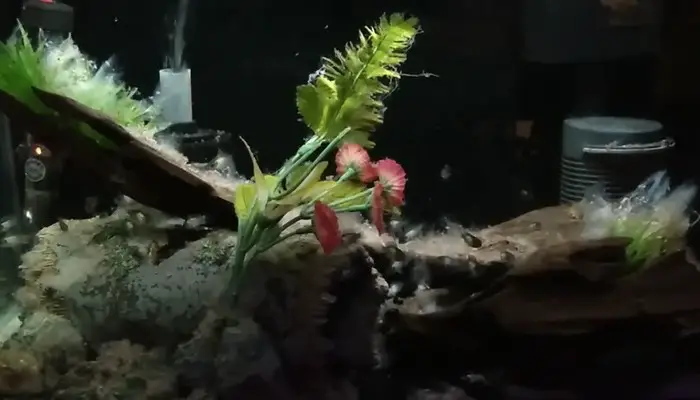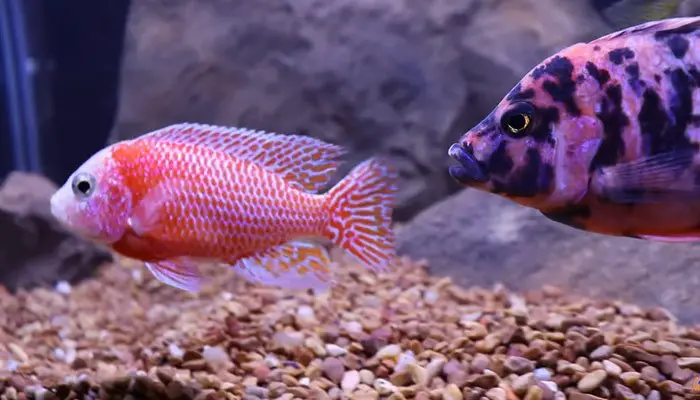Aquarium Sand Turning Black [Causes and Solutions]
Sand is popularly used as an Aquarium substrate across the world. It requires high attention to choose good quality sand for your aquarium. But it is awful to see your favorite sand turning black in your aquarium, isn’t it?
But don’t worry, I am here with all the possible solutions that you can use to solve this problem and, in this article, you are going to know about the reasons that are responsible for your aquarium sand turning black
There are many reasons behind this problem. “Black Algae” is the main culprit. Besides high levels of some minerals like iron, manganese, and phosphate in the aquarium water, the use of colored materials for decoration, and the supply of excessive amounts of light.
Why is Aquarium Sand Turning Black And Solution

1. Black Algae
In most cases, it is Black Algae that causes the aquarium sand to turn black. At the beginning of their lives, they have the shape of a mold and when they are allowed to grow they eventually take the shape of black hair-like things. They are normally found in ponds, pools, and artificial water tanks as well.
There are some reasons for algae in your tank. The reasons are given below
The Reasons for Algae Growth
- Contaminated plants can be the cause of this problem. Sometimes you do not notice that the plant you are going to put in your tank contains a tiny amount of algae in it. After some days the algae begin to grow and show its presence in the tank.
- Sometimes you exchange the substrates between two different tanks and this is how a substrate that is already infected with algae gets transferred into a fresh and uninfected tank and infects the other plants and things in that new tank.
- There are various things that are used in a tank for decoration. The things of decoration can be infected with algae and after putting them in a tank the infection spreads.
- An excessive supply of light is another reason for algae growth. When the aquarium lights are on for more than 10 to 12 hours, which is not actually needed, it can cause algae growth.
Solution
- You can apply hydrogen peroxide (3%) (Our Pick: Amazon Basics Hydrogen Peroxide) in the affected area to get rid of the algae.
- You can try a temporary blackout. It means you can keep the aquarium lights off for some days so that the algae do not get enough light to conduct their process of photosynthesis. So if they do not get enough light, they may automatically reduce their growth.
- Some algae-eating fish can be added to the tank. There are some fish like Otocinclus fish, Twig Catfish, and live bearers that will eat up all the algae in your tank happily.
- You have to make sure that the material you are putting in your tank is not infected and fresh.
2. Anaerobic Bacteria And Fungal Colonies

The aquarium sand can turn black also for the growth of anaerobic bacteria and fungal colonies.
Anaerobic bacteria and fungal colonies are created mainly by leftover foods that are given to the fishes in the tank but somehow the fishes overlooked the foods and the foods reach the substrate and support the bacteria and fungal colonies to build.
These bacteria and fungal colonies eventually end up making the aquarium sand turn black.
Solution
- Do not give excessive amounts of food to the fish. You have to give the fish food in an amount that is appropriate for the fish.
- Remove the uneaten foods. Even if you put excessive foods that the fish have overlooked, You must remove the uneaten foods as soon as possible so that they can not reach and settle on the substrate permanently.
3. Production of Hydrogen Sulfide
The organic wastes that are released from fish and animals in the tank and the leftover foods get mixed up and produce Hydrogen Sulfide that makes the tank smell like rotten eggs.
This Hydrogen Sulfide also creates black patches in the sand that will look ugly in the aquarium.
Solution
- You have got to clean your aquarium on a regular basis.
- Do not let the leftover food and organic wastes remain in the tank for a long time and settle in the substrate permanently.
4. High Levels of Minerals
Sometimes the levels of minerals such as iron, manganese, and phosphate in the tank water get high and the sand starts looking black.
As this high level does not do any serious harm to the plants and animals in the aquarium, you can easily ignore the problem if you want. But it will make the tank look ugly which is not acceptable.
In many areas, tap water contains a high level of minerals which is the main cause of this problem. Because some people in these areas use tap water in their tanks.
You can use mineral testing kits to test the mineral level that will help you to take a proper and effective step.
Solution
- Use distilled water. Distilled water is free from all the minerals that are found in tap water and water from other sources.
- You can use purified or RO water as well.
- Using phosphate-absorbing media in your filter is also an effective option. It will remove all the phosphate particles from the water and you can use it in your tank without worries.
5. Using Colour Substrate Or Decoration
If you use color substrate or some materials to decorate the tank and colors from them get mixed up with the water and gradually reach and settle on the sand it can cause the sand turning black or something else in color.
Solution
The only solution to this problem is not to use such substrate or any decoration material in which color gets mixed up with the water. You should use high-quality materials as substrate or decoration.
Tips to Maintain Aquarium Properly -A Quick Guide

- Use clean water.
- Put friendly species of fish and animals in the tank that do not eat each other.
- Do not put unhealthy and infected plants and animals in the tank.
- Choose a tank size that can contain all your plants and animals in a comfortable free space.
- There are some algae-eating fish and insects that look very attractive in the tank and will clean up all the algae by eating them.
- Use better quality lights and keep them on for 10 to 12 hours a day.
- Keep the temperature between 75 Fahrenheit to 80 Fahrenheit.
- Freshwater fish and animals live well with a pH level of 6.6 to 6.8 and saltwater fish and animals live well with a pH of 7.6 to 8.4. So keep the pH accordingly.
- Make sure the essential minerals are in proper balance.
- Do not use contaminated materials for decoration.
Frequently Asked Questions
Why Is The Aquarium Sand Turning Brown?
This generally happens because of the Presence of excessive amounts of nutrients in the water like silica or nitrate etc. The presence of silica might be due to using tap water that is high in silica acid. It can also come from some kinds of substrate like silica sand.
Are Brown Algae Harmful To The Fish And Animals In Aquariums?
The problem of brown algae is very commonly seen in aquariums. This problem is mostly faced in the tanks that are newly set up. The algae do not harm the plants and animals but destroy the aesthetic beauty of the tank. It can cover up everything in the tank including decorations, substrate, and plants, and make your tank an ugly mess.
Is Aquarium Sand Hard To Clean?
Not really. Cleaning and maintaining aquarium sand is very much. Though the cleaning process is a little bit different, it is much easier than cleaning the gravel.
Final words
Now you know the reasons behind the aquarium sand turning black and the solutions to it as well.
I have also mentioned some tips that are hopefully going to help you to maintain your aquarium efficiently.
- Axolotl Upside Down – Understanding, Preventing, And Treating Buoyancy - January 6, 2026
- Axolotl Fungal Treatment – Your Definitive Guide To Happy, Healthy - January 6, 2026
- Olm Vs Axolotl – A Comprehensive Guide To Choosing Your Perfect - January 6, 2026
